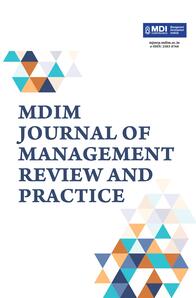
1JIS University, Kolkata, West Bengal, India
Creative Commons Non Commercial CC BY-NC: This article is distributed under the terms of the Creative Commons Attribution-NonCommercial 4.0 License (http://www.creativecommons.org/licenses/by-nc/4.0/) which permits non-Commercial use, reproduction and distribution of the work without further permission provided the original work is attributed.
The global COVID-19 pandemic had created an unforeseen situation across the country affecting normal academics in schools, academic institutions and universities. These had compelled policymakers, academic think tanks, institutional heads, faculty members and others to quickly adopt online mode of teaching and learning in order to safeguard the well-being of students, faculty, staff and their family members from the spread of the virus. However, adopting to the online mode of teaching and learning was not an easy affair for either the student or teaching community. In spite of all the adversities and impending challenges, students had to adopt with the online mode of learning for which they needed to harness and sharpen their digital acumen and technical know-how. Taking this perspective into consideration, an attempt has been made in the present study to have an understanding of what was meant by digital acumen for students studying postgraduate business studies in the institutions located in and around the National Capital Region (NCR) of Delhi and explore the factors influencing the same. For this purpose, the research used a sequential mixed method research design whereby, based on the existing literature and research gaps the first (qualitative) phase, made an attempt to explore the narratives of institutional heads regarding what was meant by digital acumen for postgraduate business study students and what factors influenced the same. The qualitative study led to the identification of three variables, namely support from teachers, support from peers and technical knowledge. During the subsequent quantitative phase of the research, the study explored the influence of these variables on the digital acumen of students based on an online survey among 335 students from the NCR. Data analysis indicates that technical knowledge was the most important mediator of digital acumen among the students. Support from teachers was an important predictor influencing both technical knowledge and support from peers. The variable support from peers has significant influence on technical knowledge thereby establishing the influence on digital acumen of students.
digital acumen, online learning, COVID-19, postgraduate business study students
Introduction
Academic institutions and universities across India went through an unprecedented situation due to the global COVID-19 pandemic, which brought normal classroom teaching and learning to a standstill for almost an entire year. In order to look after the health and safety issues of students and faculty members, academic institutions across the country adopted the online mode of teaching–learning. Initially, with limited resources and lack of prior training and exposure, it was difficult for many students and even faculty members to cope with the challenges of online teaching and learning which needed digital acumen and know-how. As most of the teaching and learning activities were done using online platforms, students who did not have prior technical knowledge and digital acumen had to learn, adjust and develop essential practical skill sets to effectively attend their routine classes and perform their academic activities using the online mode.
Taking this as an issue of concern for many students, an attempt has been made in the present research to explore what is meant by digital acumen for students and what factors influenced their digital acumen. The study is conducted keeping in mind the postgraduate business study students from National Capital Region (NCR).
Review of Literature
The relevance and importance of digital acumen, particularly in terms of digital and information literacy, in education had been discussed by authors like Sunarjo (2021). Authors such as Dhawan (2020) and Mishra et al. (2020) highlighted the imminent challenges faced by students during online learning during the COVID-19. Bordoloi et al. (2021) conducted a study in the Indian context involving students during the COVID-19 and indicated the importance of blended learning as an emerging reality in the landscape of today’s academics. Other researchers like Gautam and Gautam (2021) found the importance of infrastructure, student–teacher interaction, infrastructure and availability of technology as antecedent factors influencing the effectiveness of online teaching among students in Nepal. Yassin et al. (2021) explored the psychological impact of the global pandemic among students studying in Malaysian universities. In this regard, Tan (2021) explored the influence of the global pandemic on the student learning and academic performance perspectives. Similarly, Sarea et al. (2021) highlighted the issues affecting digitalized accounting education in the context of Middle East countries. On the other hand, some other authors (Chandra, 2020; George & Thomas, 2020) discussed the emotional and stress- and anxiety-related issues and coping strategies used by students to cope up with the challenges of online learning. Zia (2020) discussed the importance of factors such as student training, technology expertise, academic curriculum, motivation and attitude (Ismaili, 2021) on the effectiveness of online learning perspectives among students. A similar study conducted by Tejedor et al. (2020) indicated that teaching methodology, interaction with students and digital skills were essential for online teaching and learning in European countries such as Spain and Italy. Most of these studies, however, had not made any insights on exploring the factors influencing the digital acumen of students which is the agenda of this research and justifies the existence of a major research gap.
The growing importance of digital literacy among students has been discussed in a recent study conducted by Sunarjo (2021), who justified that digital literacy among the student community varied from country to country. Öncül (2020) indicated that first semester university students showed lack of essential digital skill sets and needed institutional help from faculty members for facilitating the same. Other authors such as Cetindamar and Abedin (2020) discussed the relevance of digital abilities of people in the organizational context. Although recent literature identified from studies conducted by Sarea et al. (2021) and Yassin et al. (2021) emphasized the importance of digital abilities, few in-depth insights were available regarding what was meant by digital acumen for students using online mode of learning during the COVID-19 which left the scope for the present study to bring about in-depth insights on this unexplored perspective.
The study conducted by Tuamsuk and Subramaniam (2017) explored various factors that influenced the digital literacy of students in the context of Thailand. The authors indicated that infrastructure, technical assistance, and academic and collaborative support were essential for influencing digital skill sets among students. In this context, a very recent study conducted by Gautam and Gautam (2021) explored factors such as IT infrastructure, teacher support and student support as essential factors influencing the adaptation of online teaching in higher education during the global pandemic.
Rizvi and Nabi (2021) highlighted the importance of relevant technical and information technology infrastructure in institutions for facilitating online teaching and learning. The study also discussed the challenges and issues pertaining to home environment which the authors indicated to have affected the learning effectiveness in students. Gautam and Gautam (2021) argued that infrastructure played an important role in the transition of higher education from offline to online mode during the COVID-19 lockdown. Previously, Muirhead (2000) had also justified the relevance of digital infrastructure for facilitating online education in the Canadian context. Based on these understandings, it is clear that technological infrastructure played an important role in the effectiveness of online teaching and learning, but whether it contributed to digital acumen was not explored in the context of the COVID-19 perspective.
The study conducted by Leino Lindell (2020) and, off late, Rizvi and Nabi (2021), indicated the importance of support from institutions by teachers for facilitating digitalization of teaching. Earlier, Gilbert (2018) discussed the importance of support and networking with their teachers for their academic performance. In a similar context, Leifler (2020) pointed out that teachers played an important role in facilitating inclusive learning to students. Similar arguments had earlier been justified by several other authors (e.g., Tamm et al., 2019; Timperley et al., 2007). Very recently, a study (Kulal & Nayak, 2020) conducted in the state of Karnataka, India, showed that students were satisfied with the support from their teachers for their online classes. Hence, it is understood that most of these studies have either indicated the importance of, or satisfaction with, the support of teachers for digital teaching and learning. None of these studies have distinctively revealed whether support from teachers contributed towards digital acumen of the students, which leaves a potential research gap for further exploration.
The study conducted by Fisher and Baird (2005) had discussed the importance of collaborative learning during web-based or online courses. Similarly, in another research conducted by Karunanayaka et al. (2016), it was shown that peer-based support had an important role to play for online learning. Earlier, Akyol et al. (2010), Harris and Sandor (2007) and Baran and Correia (2009) presented a similar perspective on the same issue. These studies have not been conducted to reveal whether support from peers contributed towards the development of digital acumen in students, leaving a research gap for further insights on the same.
The research conducted by Muirhead (2000) discussed the importance of technical support for effective online education at school level. Kulal and Nayak (2020) mentioned in their study that technical issues were important for the effectiveness of online studies among students. Another recent study conducted by Sarker et al. (2019) revealed the importance of e-learning technologies for effective online teaching and learning of students in Bangladesh. Authors like Dhawan (2020) also discussed the relevance of technical know-how for facilitating digital learning among students. Similarly, the study conducted by Chen et al. (2021) clearly indicates that student satisfaction towards online teaching and learning was correlated with content coverage and know-how of online technologies. These evidences clearly indicate that most researches had highlighted the importance of technical knowledge in the effectiveness of online learning of students, which indicates that whether technical knowledge contributed towards digital acumen was not thoroughly explained by any of these studies.
The review of literature had provided a partial picture of what was meant by digital acumen and what factors contributed to the same. Taking the context of postgraduate management students attending online mode of teaching during COVID-19, hardly any research data is found which leaves the present study to highlight the research objectives based on the research gaps identified from the review of literature (Table 1).
Table 1. Research Gaps, Research Objectives.
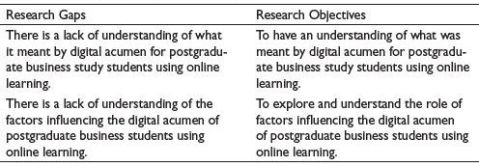
Source: The author.
Based on the research gaps and objectives mentioned in Table 1, the following research questions were raised:
RQ1. What was meant by digital acumen for postgraduate business study students using online learning?
RQ2. What are the factors influencing the digital acumen of postgraduate business students using online learning?
Research Methods
The research used a sequential mixed methodology design of which the first part was qualitative in nature and second part quantitative. The first part of the study, which was qualitative in nature, was aimed to collect the narratives of 10 heads of institutions/departments from reputed postgraduate business study institutions located in and around the NCR. The narratives were collected from the respondents using purposive sampling method with an objective to have an in-depth understanding of what was meant by digital acumen for the postgraduate business students attending online mode of learning and what kind of social phenomena underlined the causal factors which influenced their digital acumen. The narratives collected during this part of the research were analysed using N-Vivo 10, which led to the identification of sub-themes leading to the presentation of broader themes describing the social phenomenon behind the factors influencing digital acumen of postgraduate business students.
The second part of the study, which was qualitative in nature, used the research instrument developed from the sub-themes and broad themes identified from the qualitative part of the research to collect data from 335 postgraduate business students located in and around the NCR attending online mode of learning at their institutions. The names and details of the students were chosen based on prior data shared by personal network. Each student name was systematically coded, and the samples were drawn randomly from the list of coded students. Data collected from the online survey using Google Forms were analysed using SPSS Statistics 20.0, AMOS 20.0 and Gaskin’s Statistical Tool Package Excel spreadsheet.
Table 2. Identification of Trigger and Probing Questions from the Research Gap and Research Questions Emerging from the Review of Literature.

Source: The author.
Part 1: Qualitative Phase
The research gaps and research questions identified from the review of literature (Table 1) were used to develop trigger and probing questions (Table 2) for facilitating the qualitative inquiry (Part 1 of the study). The narratives were recorded and analysed simultaneously using Grounded Theory approach which helped the researcher have the most in-depth and saturated understanding of the social phenomena studied by facilitating an on-going interaction with the head of the institutions of postgraduate business study colleges located in the NCR.
Qualitative Data Analysis Using N-Vivo 10 Application
The grounded theory approach helped the researcher to develop narrative transcripts that were fed into NVivo 10 software for qualitative data analysis. The transcripts were analysed into sub-themes that represented the social phenomena discussed in the texts based on the narratives presented by the head of the institutions. The sub-themes were subsequently presented into broad themes and the same were tabulated in the form of outputs generated by N-Vivo 10 application (Table 3).
Table 3. Sub-Themes and Broad Themes Identified from the Narrative Transcripts Using N-Vivo 10 Application.

Source: The author.
The qualitative phase has brought out a meaningful understanding of digital acumen, where the later has been identified as the ability of users (postgraduate business study students) to apply digital know-how, communicate, collaborate and solve problems by applying digital tools and technology.
In the next stage, the above sub-themes and broad themes were used to identify the respective measures and the constructs which were used in the research instrument (Table 4) emerging from the qualitative phase of the research. The instrument used a five-point Likert scale (1 = Strongly Disagree, 2 = Disagree, 3 = Neutral, 4 = Agree and 5 = Strongly Agree) to record and collect respondent responses. Control variables such as gender, age and work experience were also included in the questionnaire for collecting personal data of the respondents.
Table 4. Constructs and Their Corresponding Measures used in the Research Instrument Emerging from the Qualitative Phase of the Research.
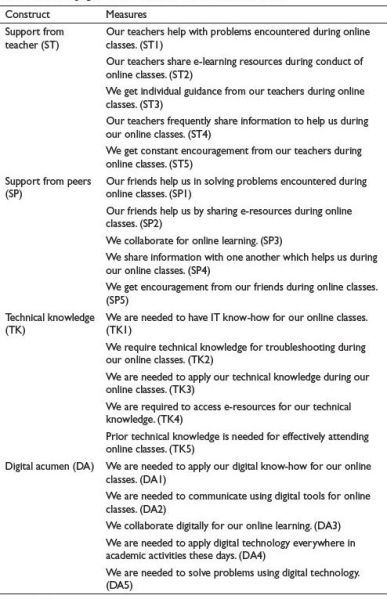
Source: The author.
Figure 1. Modified Conceptual Model After Qualitative Study.
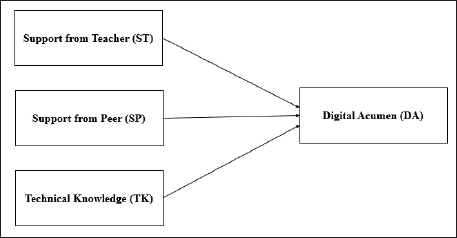
Source: The author.
Table 5. Proposed Hypothesis.
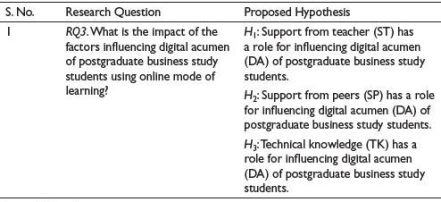
Source: The authors.
Modified Conceptual Model and Development of Hypothesis
Based on the aforementioned emerging variables and their corresponding measures derived from the qualitative phase, the preliminary conceptual model developed from the review of literature was presented as (Figure 1).
Further review of the research gaps explored from the review of literature (Table 5) and the aforementioned modified conceptual model emerging after the qualitative phase, three hypotheses were proposed (Table 5).
Table 6. Respondent Profile.
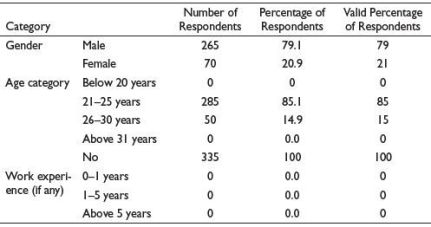
Source: The author.
Part 2: Quantitative Phase
During the Part 2 of the study, which was quantitative in nature, the research instrument developed from the qualitative phase of the research was used for collecting data from 335 postgraduate business study students located in the NCR using online survey method (Google Forms). These students were using the online learning mode in their institutions due to the COVID-19 restrictions.
Data Analysis
Respondent Profile
Data collected from the online survey (Google Forms) were downloaded in an excel spreadsheet and were subjected for rigorous check and data cleaning for making them ready for feeding in SPSS Statistics 20.0 application. As indicated in Table 6, 79% respondents were male whereas 21% respondents were female; 85% respondents were in the age group of 21–25 years, and the remaining 15% belonged to the age group of 26–30 years. All the respondents were freshers’ and had no prior work experiences.
Table 7 indicates that all the constructs had adequate (above 0.800) reliability scores individually. The construct support from peers had the highest mean score of 3.62, followed by digital acumen 2.77. Technical knowledge and support from teacher had mean scores of 2.59 and 2.58, respectively.
Exploratory Factor Analysis (EFA)
The data was subsequently analysed for exploratory factor analysis (EFA) in order to evaluate whether any measure pertaining to the corresponding construct were not contributing significantly towards the construct. In order to run the EFA, the data were run through Kaiser-Meyer-Olkin (KMO) and Bartlett’s Test. The KMO measure of sampling adequacy score of 0.867 (Table 8) revealed that the data could be used for the further stages of factor analysis.
The rotated component matrix (Table 9) computed from EFA, revealed that, for the construct support from peers all the measures, SP1, SP2, SP3, SP4 and SP5, were contributing to the construct as their factor loadings were above 0.6. For the construct, technical knowledge, the measures TK4 and TK5 were having factor leadings below 0.6 for which they were found to be not contributing significantly towards the construct technical knowledge.
Table 7. Descriptive Statistics and Reliability (Cronbach’s Alpha) Scores for the Constructs.
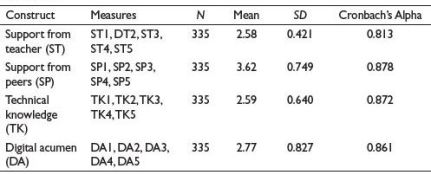
Source: The author.
Table 8. KMO and Bartlett’s Test.

Source: The author.
Similarly, for the constructs support from teacher, the measures ST4 and ST5 and digital acumen (DA), the measures DA4 and DA5 were found to have factor loadings below 0.6.
Confirmatory Factor Analysis (CFA)
Based on the inputs obtained regarding the measures for each construct, the data were fed into AMOS 20.0 for conducting confirmatory factor analysis (CFA), followed by path analysis using structural equation modelling (SEM) and a measurement model was developed for the same (Figure 2).
Table 9. Rotated Component Matrixa Identified from EFA.
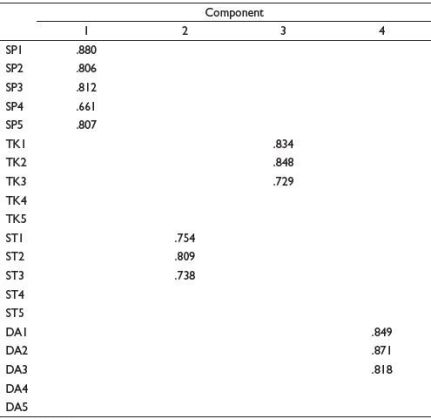
Source: The author.
Notes: Extraction method: Principal component analysis; Rotation method: Varimax with Kaiser Normalization; aRotation converged in 5 iterations.
The standardized regression estimates and estimates of correlation derived from the AMOS output of the measurement model (Figure 2) were fed into Gaskin’s Statistical Tool Package Excel spreadsheet (Table 10) for analysing the validity of the data in terms of computing the average variance extracted (AVE) as the determinant of convergent validity and maximum shared variance (MSV) as the determinant of discriminant validity. Table 10 indicates that all the constructs namely technical knowledge, support from teachers, support from peers and digital acumen had adequate scores above the prescribed value of 0.5 for AVE, indicating that these variables had acceptable convergent validity. On the other hand, as the MSV scores for each construct were below their corresponding scores for AVE, the variables could be interpreted to have adequate discriminant validity.
The model fit estimates extracted from AMOS output (Table 11) indicates that the measurement model presented in Figure 2 had adequate estimates pertaining to root mean square residual (RMR) [0.055; score nearer to zero], goodness of fit index (GFI) [0.906; acceptable limit 0.9; good fit
0.9; good fit 0.95], comparative fit index (CFI) [0.948; good fit
0.95], comparative fit index (CFI) [0.948; good fit 0.9] and root mean square error of approximation (RMSEA) [0.078; good fit < 0.08] (Hooper et al., 2008; Kline, 2005; Parry, 2018).
0.9] and root mean square error of approximation (RMSEA) [0.078; good fit < 0.08] (Hooper et al., 2008; Kline, 2005; Parry, 2018).
Figure 2. Measurement Model Developed for CFA.
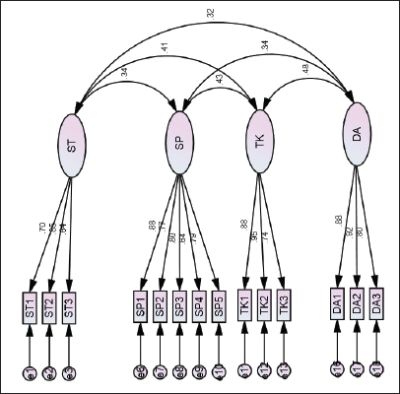
Source: The author.
Path Analysis using SEM
Based on the acceptable estimates of the CFA, the measurement model (Figure 3) for path analysis using SEM was developed using digital acumen as the dependent variable and support from teacher, support from peers and technical knowledge as independent variables.
Regression estimates (Table 12) of the measurement model (Figure 4) indicates that out of the three independent variables, only technical knowledge had significant implications (Std. β = 0.366, p < .05) on the digital acumen of postgraduate business study students. The other factors, namely support from teachers (Std. β = 0.121, p > .05) and support from peers (Std. β = 0.143, p > .05), had no significant implications on digital acumen.
Figure 3. Measurement Model for Path Analysis.
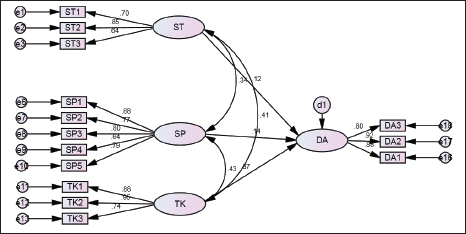
Source: The author, using AMOS output.
Table 10. Computation of Convergent and Discriminant Validity Scores.

Source: The authors, using AMOS output and output from Gaskin’s Statistical Tool Package.
Table 11. Model Fit Estimates for the Measurement Model.

Source: The author, using AMOS output.
Table 12. Regression Estimates of the Measurement Model.

Source: The author, using AMOS output.
Table 13. Covariance Estimates of the Independent Variables in the Measurement Model.

Source: The author, using AMOS output.
Figure 4. First Order Measurement Model.
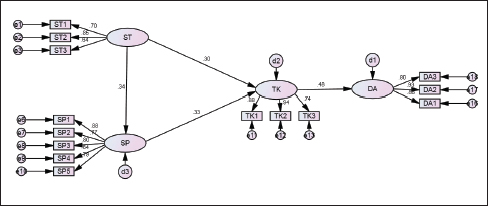
Source: The author, using AMOS output.
In order to have a detailed understanding of the interrelationships between the independent variables, their covariance estimates were also computed (Table 13).
Table 13 indicates that support from teachers had significant covariances with support from peers and technical knowledge. Similarly, support from peers also had significant covariance with technical knowledge. Based on this understanding, the first order measurement model (Figure 4) was developed.
Regression estimates (Table 14) for the first order measurement model indicates that support from teachers had significant relations with (Std. β = 0.335, p < .05) support from peers as well as (Std. β = 0.302, p < .05) technical knowledge. Support from peers on the other hand had significant relation (Std. β = 0.333, p < .05) with technical knowledge, while the later had significant relationship (Std. β = 0.484, p < .05) with digital acumen.
Presentation of the Empirically Tested Model after Data Imputation
Based on the estimates of the first order measurement model (Figure 5), data imputation was conducted on AMOS which resulted in the presentation of the empirically tested model (Figure 5).
Table 15 indicates that technical knowledge emerged as the most important mediator (Std. β = 0.519, p < .05) for facilitating the digital acumen of postgraduate business study students attending online mode of learning from their institutions during the COVID-19.
Table 14. Regression Estimates for the First Order Measurement Model.

Source: The author, using AMOS output.
Figure 5. Empirically Tested Model After Data Imputation.
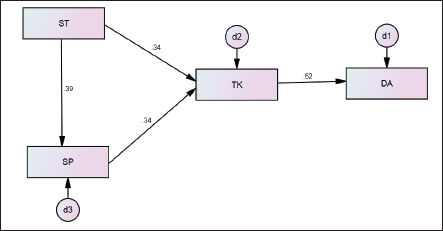
Source: The author, using AMOS output.
Table 15. Regression Estimates for the Empirically Tested Model.

Source: The author, using AMOS output.
On the other hand, support from teachers was found to be the most important determinant factor which facilitated (Std. β = 0.338, p < .05) technical knowledge as well as (Std. β = 0.386, p < .05) support from peers among the students. The impact of support from peers on digital acumen was mediated by significantly influencing (Std. β = 0.340, p < .05) technical knowledge. Technical knowledge had significant relationship (Std. β = 0.519, p < .05) with digital acumen.
The above empirically tested research model (Figure 5) was further validated by the model fit estimates computed from AMOS output (Table 16). Table 16 indicates that the empirically tested model (Figure 5) presented above had adequate estimates pertaining to RMR [0.022; score nearer to zero], GFI [0.988; acceptable limit 0.9; good fit
0.9; good fit 0.95], CFI [0.981; good fit
0.95], CFI [0.981; good fit 0.9] and RMSEA [0.021; good fit < 0.08] (Hooper et al., 2008; Kline, 2005; Parry, 2018).
0.9] and RMSEA [0.021; good fit < 0.08] (Hooper et al., 2008; Kline, 2005; Parry, 2018).
Table 16. Model Fit Estimates for the Empirically Tested Research Model.

Source: The author, using AMOS output.
Discussions
Research objective: To have an understanding of what was meant by digital acumen for postgraduate business study students using online learning.
Part 1 of the study had explained digital acumen as the ability of users (postgraduate business study students) to apply digital know-how, communicate, collaborate and solve problems by applying digital tools and technology. In existing literature, digital acumen has been described as the ability of people to have an understanding of advanced technologies so as to create competitive advantages by effective utilization of data on real-time basis for effective decision-making (Brousell, 2019). On the other hand, Bokek-Cohen (2018) ascribed digital skills of employees as signals with which they could implicitly facilitate use of data and information for the needs of their organizations. It is evident that the implications pertaining to the understanding of digital acumen for postgraduate business study students and working employees were different and unique. Students emphasized more upon digital know-how which contributed towards their learning, whereas the use of digital tools was also important for them to communicate and collaborate effectively during their lecture delivery and learning. Furthermore, the present study also revealed that postgraduate business students also needed to use digital tools and technology to solve problems related to their academics which was an essential component of their learning and development.
Research objective: To explore and understand the role of factors influencing the digital acumen of postgraduate business students using online learning.
The qualitative phase (Part 1) of the study helped the researchers to explore the factors which contributed mostly towards the digital acumen among postgraduate business students. Although the existing literature had highlighted factors such as infrastructure, technical assistance, academic and collaborative support, teacher support and student support to be instrumental for developing digital abilities among people, the qualitative analysis had shown that the subject matter experts which included head of postgraduate business study institutions identified support from teachers, support from peers and technical knowledge as the most important factors contributing towards the development of digital acumen among students.
In order to understand the impact of the above factors, the Part 2 of the study which was essentially quantitative in nature came out with an empirically tested model revealing the following relationships between the variables.
Impact of Technical Knowledge on Digital Acumen
The empirical model (Figure 5) established by using SEM indicated that among the three factors, technical knowledge was the only antecedent which had significant implications (Std. β = 0.519, p < .05) on the digital acumen of postgraduate business students. The study conducted by Bejakovi and Mrnjavac (2020) indicates that digital literacy was essential for developing digital skills among people which further contributed towards socio-economic development. On the other hand, authors such as Cetindamar and Abedin (2020) discussed the importance of digital literacy for the development of digital skills among people in organizational set-up. Another study conducted by Bergdahl et al. (2020) pointed out that with increasing digitalization of modern education, students needed to inculcate technology-enabled learning so as to remain effective. Similar perspectives have also been reflected in the insights presented by Sunarjo (2021), who emphasized that digital and information literacy was an essential contributor of education. On the other hand, Nadkarni and Prügl (2021) emphasized on various aspects of technical knowledge assimilation which contributed effectively towards digital transformation. Based on these existing research evidences, it can be said that the findings of the present study had established the empirical relationship between technical knowledge and digital acumen with reference to postgraduate business study students which had not been reflected in earlier or recently conducted studies.
and Mrnjavac (2020) indicates that digital literacy was essential for developing digital skills among people which further contributed towards socio-economic development. On the other hand, authors such as Cetindamar and Abedin (2020) discussed the importance of digital literacy for the development of digital skills among people in organizational set-up. Another study conducted by Bergdahl et al. (2020) pointed out that with increasing digitalization of modern education, students needed to inculcate technology-enabled learning so as to remain effective. Similar perspectives have also been reflected in the insights presented by Sunarjo (2021), who emphasized that digital and information literacy was an essential contributor of education. On the other hand, Nadkarni and Prügl (2021) emphasized on various aspects of technical knowledge assimilation which contributed effectively towards digital transformation. Based on these existing research evidences, it can be said that the findings of the present study had established the empirical relationship between technical knowledge and digital acumen with reference to postgraduate business study students which had not been reflected in earlier or recently conducted studies.
Role of Support from Teachers on Technical Knowledge
and Digital Acumen
The empirical model (Figure 5) established in the study revealed that the variable support from teachers emerged as an important influencing factor which contributed towards the development of digital acumen of postgraduate business study students with the mediation of technical knowledge (Std. β = 0.338, p < .05) and support from peers (Std. β = 0.386, p < .05). The results indicate that support from teachers was instrumental for developing technical knowledge among students which contributed towards their digital acumen. On the other hand, support from teachers was also important for influencing peer support which further facilitated (Std. β = 0.340, p < .05) the development of technical knowledge among the students.
Impact of Support from Teachers on Technical Knowledge of Students
The present study had revealed that technical knowledge acted as a mediating factor between support from teachers and the digital acumen of postgraduate management students. The significant relationship between support from teachers and technical knowledge (Std. β = 0.338, p < .05) indicates that teachers played an important role in incorporating all the domain knowledge to the postgraduate business study students which helped them to develop and sharpen their digital acumen during the conduct of online studies. According to Laurillard et al. (2016), Salleh (2016) teachers played an important role for facilitating and bringing about innovations in learning pedagogies and imparting digital skills among students. Similarly, Lindberg et al. (2017) emphasized on the role of teachers for the effective implementation of Information and Communication Technology (ICT) during online studies. Early studies conducted by Howard (2013) discussed that teacher abilities and attitudes towards the use of ICT was essential for effective content delivery. Amin and Mirza (2020) discussed that teachers played a crucial role for online delivery of studies in virtual set-ups. These literature evidences justified that the findings of the present study were unique in terms of establishing an empirical relationship between the role of support from teachers for enhancing the technical knowledge among postgraduate business study students.
Impact of Support from Teachers on Support from Peers
The study had also highlighted the significant relationship between support from teachers and support from peers for postgraduate business students. This finding could be justified by the evidence from a study conducted by Azila-Gbettor and Abiemo (2020) who suggested that lecturer support acted as an important contributor of student self-efficacy and class engagement. The study conducted by Huang et al. (2010) had earlier established the relationship of teacher support and support from others in academic institutions. Another research conducted by Kiefer et al. (2015) showed that teacher support and peer support in academic institutions were instrumental for fostering student motivation and academic involvement. The findings of the present research had thereby established an empirical evidence pertaining to the influence of support from teachers being instrumental for fostering support from peers among the postgraduate business study students.
Role of Support from Peers on Technical Knowledge and Digital Acumen
As evident from the empirical model (Figure 5) presented in this study, the influence of support from peers on the digital acumen of postgraduate management students was mediated by the factor technical knowledge. Regarding the significant relationship (Std. β = 0.340, p < .05) established between support from peers and technical knowledge, it can be mentioned that earlier studies as those conducted by Karunanayaka et al. (2016) showed that peer-facilitated environments were important for facilitating learner engagement in a structured way, which indicates that the variable had important contribution towards learner knowledge accumulation. In this regard, Naidu (2006) discussed the importance of group support for effective ICT-based learning. The impact of peer support-based environments on ICT-based learning had been discussed and supported in the studies conducted by Ching and Hsu (2013) and Xia et al. (2013). In this context, as no conclusive evidence could be cited in the existing literature regarding the empirical relationship between support from peers and technical knowledge, the present study had added new insights in the existing body of knowledge.
Implications of the Study
The article has contributed effectively in terms of academic or methodological, practical and sociological consideration which would facilitate academicians as well as industry practitioners use similar approaches for investigating similar problems pertaining to learning and development using online methods during the continued saga of the global pandemic. Considering the methodological perspective, the present study had used sequential mixed methodology where the qualitative phase was instrumental to explore insights on what was perceived to be digital acumen for postgraduate business study students and also identify antecedents influencing the same. At the same time, the quantitative phase used the insights developed from the qualitative phase to establish the relationship between digital acumen and the antecedent variables in the form of an empirical model using SEM. This methodological approach would motivate future researchers and academicians to explore and dig out new insights on broader issues pertaining to online learning and their implications on student learning and development during the global pandemic. From the practical perspective, the study would also encourage trainers and learning and development professionals from the industry to streamline their approaches keeping in mind the findings of the research. Keeping the sociological perspective, the study would help head of institutions in B Schools and faculty members come out with innovative approaches in their teaching pedagogy and delivery, which would provide effective and engaging learning environments for students using the online mode of higher education during the pandemic.
Limitations and Scope of the Study
The present research had been only limited to the NCR and hence has immense scope if conducted on pan-India basis. The qualitative phase, as a part of the sequential mixed methodology, could explore more antecedent factors related to student digital acumen if conducted across various streams of studies as well as on the national perspective. The study under such considerations would certainly have broader scope for exploring an in-depth understanding of the relationship between causal antecedents of digital acumen in students using the online mode of studies during the pandemic.
Conclusions
The study had highlighted the importance of technical knowledge development for facilitating digital acumen among postgraduate business study students and had also established the role of support from teachers to be the most instrumental factor to facilitate technical knowledge development and enhancing peer support among students. Peer support, on the other hand, was also found to be an important contributor towards the development of technical knowledge in students, which mediated the influences of peer support as well as support from teachers for development digital acumen among students. The empirical model presented in this research would help the head of intuitions, faculty members, researchers and corporate learning and development experts to bring about necessary changes in the existing approaches towards learner engagement and development using the online mode of teaching delivery during the COVID-19 pandemic.
Declaration of Conflicting Interests
The author declared no potential conflicts of interest with respect to the research, authorship and/or publication of this article.
Funding
The author received no financial support for the research, authorship and/or publication of this article.
Akyol, Z., Ice, P., Garrison, D. R., & Mitchell, R. (2010). The relationship between course socio-epistemological orientations and student perceptions of the community of inquiry. Internet and Higher Education, 13(1–2), 66–68.
Amin, H., & Mirza, M. S. (2020). Comparative study of knowledge and use of Bloom’s digital taxonomy by teachers and students in virtual and conventional universities. Asian Association of Open Universities Journal, 15(2), 223–238. https://doi.org/10.1108/AAOUJ-01-2020-0005
Azila-Gbettor, E. M., & Abiemo, M. K. (2021). Moderating effect of perceived lecturer support on academic self-efficacy and study engagement: Evidence from a Ghanaian university. Journal of Applied Research in Higher Education, 13(4), 991–1006. https://doi.org/10.1108/JARHE-04-2020-0079
Baran, E., & Correia, A. (2009). Student-led facilitation strategies in online discussions. Distance Education, 30(3), 339–361. https://doi.org/10.1080/01587910903236510
Bejakovi , P., & Mrnjavac, Ž. (2020). The importance of digital literacy on the labour market. Employee Relations, 42(4), 921–932. https://doi.org/10.1108/ER-07-2019-0274
, P., & Mrnjavac, Ž. (2020). The importance of digital literacy on the labour market. Employee Relations, 42(4), 921–932. https://doi.org/10.1108/ER-07-2019-0274
Bergdahl, N., Nouri, J., & Fors, U. (2020). Disengagement, engagement and digital skills in technology-enhanced learning. Education and Information Technologies, 25(2), 957–983. https://doi.org/10.1007/s10639-019-09998-w
Bokek-Cohen, Y. (2018). Conceptualizing employees’ digital skills as signals delivered to employers. International Journal of Organization Theory and Behavior, 21(1), 17–27. https://doi.org/10.1108/IJOTB-03-2018-003
Bordoloi, R., Das, P., & Das, K. (2021). Perception towards online/blended learning at the time of COVID-19 pandemic: An academic analytics in the Indian context, Asian Association of Open Universities Journal, 16(1), 41–60. https://doi.org/10.1108/AAOUJ-09-2020-0079
Brousell, D. R. (2019). In pursuit of digital acumen. Manufacturing Leadership Council. https://www.manufacturingleadershipcouncil.com/in-pursuit-of-digital-acumen-10041/
Cetindamar, K. D., & Abedin, B. (2020). Understanding the role of employees in digital transformation: Conceptualization of digital literacy of employees as a multi-dimensional organizational affordance. Journal of Enterprise Information Management, 34(6), 1649–1672. https://doi.org/10.1108/JEIM-01-2020-0010
Chandra, Y. (2020). Online education during COVID-19: Perception of academic stress and emotional intelligence coping strategies among college students. Asian Education and Development Studies, 10(2), 229–238. https://doi.org/10.1108/AEDS-05-2020-0097
Chen, C., Landa, S., Padilla, A., & Yur-Austin, J. (2021). Learners’ experience and needs in online environments: Adopting agility in teaching. Journal of Research in Innovative Teaching and Learning, 14(1), 18–31. https://doi.org/10.1108/JRIT-11-2020-0073
Ching, Y., & Hsu, Y. (2013). Peer feedback to facilitate project-based learning in an online environment. International Review of Research in Open and Distributed Learning, 14(5), 258–276. http://www.irrodl.org/index.php/irrodl/article/view/1524/2655; https://doi.org/10.19173/irrodl.v14i5.1524
Dhawan, S. (2020). Online learning: A panacea in the time of COVID-19 crisis. Journal of Educational Technology Systems, 49(1), 5–22. https://doi.org/10.1177/0047239520934018
Fisher, M., & Baird, D. E. (2005). Online learning design that fosters student support,
self-regulation, and retention. Campus-Wide Information Systems, 22(2), 88–107. https://doi.org/10.1108/10650740510587100
Gautam, D. K., & Gautam, P. K. (2021). Transition to online higher education during COVID-19 pandemic: Turmoil and way forward to developing country of South Asia–Nepal. Journal of Research in Innovative Teaching and Learning, 14(1), 93–111. https://doi.org/10.1108/JRIT-10-2020-0051
George, G., & Thomas, M. R. (2020). Quarantined effects and strategies of college students – COVID-19. Asian Education and Development Studies, 10(4), 565–573. https://doi.org/10.1108/AEDS-04-2020-0054
Gilbert, M. (2018). Student performance is linked to connecting effectively with teachers. Journal of Research in Innovative Teaching and Learning, 12(3), 311–324. https://doi.org/10.1108/JRIT-05-2018-0010
Harris, N., & Sandor, M. (2007). Developing online discussion forums as student centred peer e-learning environments [concise paper]. Proceedings of ASCILITE, Singapore, December 2–5. www.ascilite.org/conferences/singapore07/procs/harris.pdf
Hooper, D., Coughlan, J., & Mullen, M. R. (2008). Structural equation modelling: Guidelines for determining model fit. The Electronic Journal of Business Research Methods, 6, 53–60.
Howard, S. K. (2013). Risk-aversion: understanding teachers’ resistance to technology integration. Technology, Pedagogy and Education, 22(3), 357–372.
Huang, S., Eslami, Z., & Hu, R. S. (2010). The relationship between teacher and peer support and English-language learners’ anxiety. English Language Teaching, 3(1), 32–40. https://doi.org/10.5539/elt.v3n1p32
Ismaili, Y. (2021). Evaluation of students’ attitude toward distance learning during the pandemic (Covid-19): A case study of ELTE university. On the Horizon, 29(1), 17–30. https://doi.org/10.1108/OTH-09-2020-0032
Karunanayaka, S. P., Rajendra, J. C. N., Ratnayake, H. U. W., & Naidu, S. (2016). Peer-facilitated discussions to enhance OER-based e-learning. Asian Association of Open Universities Journal, 11(1), 90–104. https://doi.org/10.1108/AAOUJ-07-2016-0022
Kiefer, S. M., Alley, K. M., & Ellerbrock, C. R. (2015). Teacher and peer support for young adolescents’ motivation, engagement, and school belonging. RMLE Online, 38(8), 1–18. https://doi.org/10.1080/19404476.2015.11641184
Kline, R. (2005). Principles and practice of structural equation modeling (2nd ed.). Guilford.
Kulal, A., & Nayak, A. (2020). A study on perception of teachers and students toward online classes in Dakshina Kannada and Udupi District. Asian Association of Open Universities Journal, 15(3), 285–296. https://doi.org/10.1108/AAOUJ-07-2020-0047
Laurillard, D., Derrick, J., & Doel, M. (2016). Building digital skills in the FE sector: Future of skills and lifelong learning. Government Office for Science, London.
Leifler, E. (2020). Teachers’ capacity to create inclusive learning environments. International Journal for Lesson and Learning Studies, 9(3), 221–244. https://doi.org/10.1108/IJLLS-01-2020-0003
Leino Lindell, T. (2020). Teachers calling for organizational support to digitalize teaching. International Journal of Information and Learning Technology, 37(5), 323–339. https://doi.org/10.1108/IJILT-02-2020-0017
Lindberg, O. J., Olofsson, A. D., & Fransson, G. (2017). Same but different? An examination of Swedish upper secondary school teachers’ and students’ views and use of ICT in education. International Journal of Information and Learning Technology, 34(2), 122–132. https://doi.org/10.1108/IJILT-09-2016-0043
Mishra, L., Gupta, T., & Shree, A. (2020). Online teaching-learning in higher education during lockdown period of COVID-19 pandemic. International Journal of Educational Research Open, 1, 100012. https://doi.org/10.1016/j.ijedro.2020.100012
Muirhead, W. D. (2000). Online education in schools. International Journal of Educational Management, 14(7), 315–324. https://doi.org/10.1108/09513540010378969
Nadkarni, S., & Prügl, R. (2021). Digital transformation: A review, synthesis and opportunities for future research. Management Review Quarterly, 71(2), 233–341. https://doi.org/10.1007/s11301-020-00185-7
Naidu, S. (2006). E-learning: A guidebook of principles, procedures and practices. Commonwealth Educational Media Centre for Asia. http://cemca.org.in/ckfinder/userfiles/files/e-learning_guidebook.pdf
Öncül, G. (2020). Defining the need: Digital literacy skills for first-year university students. Journal of Applied Research in Higher Education, 13(4), 925–943. https://doi.org/10.1108/JARHE-06-2020-0179
Parry, S. (2018). Fit indices commonly reported for CFA and SEM. Cornell Statistical Consulting Unit, Cornell University. https://www.cscu.cornell.edu/news/Handouts/SEM_fit.pdf
Rizvi, Y. S., & Nabi, A. (2021). Transformation of learning from real to virtual: An exploratory-descriptive analysis of issues and challenges. Journal of Research in Innovative Teaching & Learning, 14(1), 5–17. https://doi.org/10.1108/JRIT-10-2020-0052
Salleh, S. (2016). Examining the influence of teachers’ beliefs towards technology integration in classroom. International Journal of Information and Learning Technology, 33(1), 17–35. http://doi.org/10.1108/IJILT-10-2015-0032
Sarea, A., Alhadrami, A., & Taufiq-Hail, G. A.-M. (2021). COVID-19 and digitizing accounting education: Empirical evidence from GCC. PSU Research Review, 5(1), 68–83. https://doi.org/10.1108/PRR-10-2020-0034
Sarker, M. F. H., Mahmud, R. A., Islam, M. S., & Islam, M. K. (2019). Use of e-learning at higher educational institutions in Bangladesh: Opportunities and challenges. Journal of Applied Research in Higher Education, 11(2), 210–223. https://doi.org/10.1108/JARHE-06-2018-0099
Sunarjo, E., (2021). Why digital and information literacy are so important to education? https://www.emeraldgrouppublishing.com/news-and-press-releases/why-digital-and-information-literacy-are-so-important-education
Tamm, L., Duncan, A., Vaughn, A., McDale, R., Estell, N., Birnschein, A., & Crosby, L. (2019). Academic needs in middle school: Perspectives of parents and youth with autism. Journal of Autism and Developmental Disorders, 50(9), 3126–3139. https://doi.org/10.1007/s10803-019-03995-1
Tan, C. (2021). The impact of COVID-19 pandemic on student learning performance from the perspectives of community of inquiry. Corporate Governance, 21(6), 1215–1228. https://doi.org/10.1108/CG-09-2020-0419
Tejedor, S., Cervi, L., Pérez-Escoda, A., & Jumbo, F. T. (2020). Digital literacy and higher education during COVID-19 lockdown: Spain, Italy, and Ecuador. Publications, 8(4), 48. https://doi.org/10.3390/publications8040048
Timperley, H., Wilson, A., & Fung, I. (2007). Teacher professional learning and development: Best evidence synthesis iteration (BES). Ministry of Education.
Tuamsuk, K., & Subramaniam, M. (2017). The current state and influential factors in the development of digital literacy in Thailand’s higher education. Information and Learning Science, 118(5/6), 235–251. https://doi.org/10.1108/ILS-11-2016-0076
Xia, J., Fielder, J., & Siragusa, L. (2013). Achieving better peer interaction in online discussion forums: A reflective practitioner case study. Issues in Educational Research, 23(1), 97–113. http://www.iier.org.au/iier23/xia.pdf
Yassin, A. A., Razak, N. A., Saeed, M. A., Al-Maliki, M. A. A., & Al-Habies, F. A. (2021). Psychological impact of the COVID-19 pandemic on local and international students in Malaysian universities. Asian Education and Development Studies, 10(4), 574–586. https://doi.org/10.1108/AEDS-05-2020-0098
Zia, A. (2020). Exploring factors influencing online classes due to social distancing in COVID-19 pandemic: A business students perspective. International Journal of Information and Learning Technology, 37(4), 197–211. https://doi.org/10.1108/IJILT-05-2020-0089